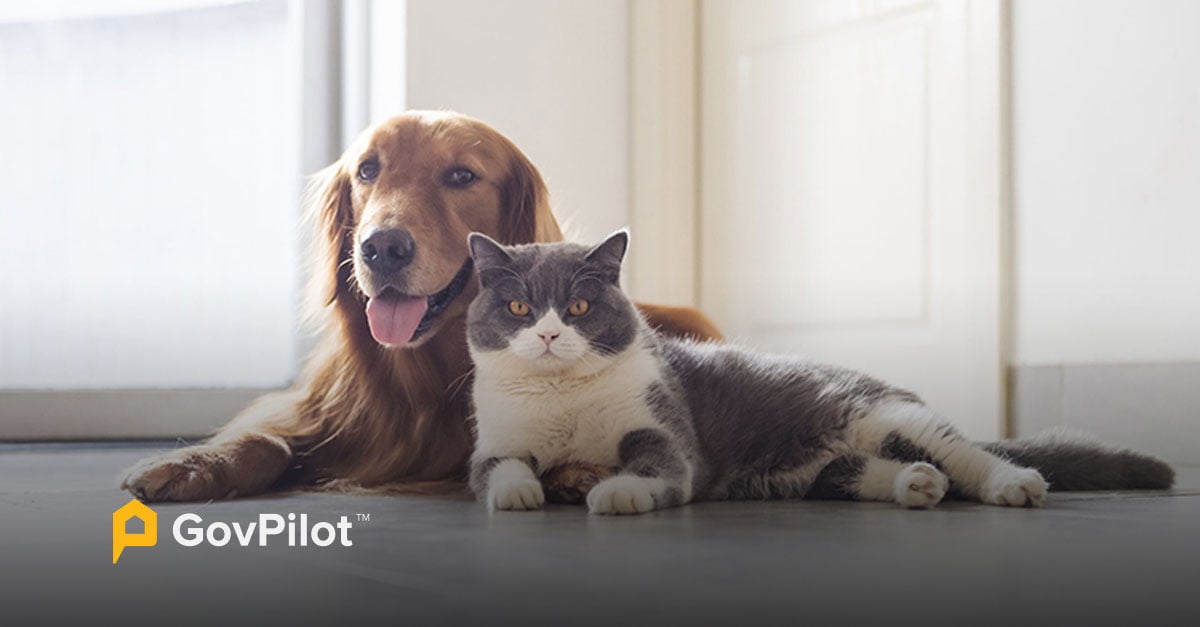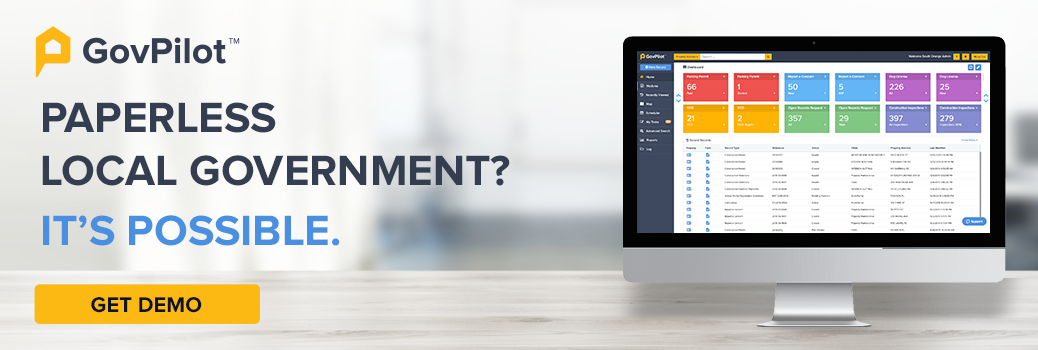Data shows that the number of household pets has increased in recent years, with a major uptick during the COVID-19 lockdowns. And while there’s so much to enjoy about the wholesome pleasure pets can bring to a family and community, more cats and dogs in your neighborhood means continued challenges for your local clerks department, health department and animal control unit to manage. And without a proper strategy, things like pet licensing, stray management, and animal vaccination can be impossible to keep organized.
In this guide you’ll come to recognize the key aspects of a modern local health department animal control strategy, and learn how government technology can make the lives of government officials and pet-owning citizens substantially easier.
Why Do Health Departments Need to Prioritize Animal Control?
Local animal control plays an integral role in the health and safety of your local citizens, their pets, as well as stray and wild animals. Failure to do things like collecting pet licenses, spaying strays, and managing animal shelters could result in loose animals on the streets and an overpopulation of stray cats and dogs.
Here are key tips for the local health department, code enforcement, and animal control to consider to ensure public safety and keep pet-related data organized.
Key Strategic Planning Considerations for Local Animal Control
To keep animal management processes organized and reduce the number of strays on the street, here are strategic planning considerations for your local government:
1. Have Pet Licensing Workflows in Place
Pet licensing is integral to your local government’s record keeping surrounding the number of pets in your community.
Local government leadership needs to have processes in place to record information about pets, their owners, and their addresses in case a pet goes missing. These documents are also important for ensuring all local pets meet vaccination (and potentially neutering) policies.
2. Plan of Action for Stray Cat and Dog Management
As of 2022 there were a reported 70,000,000 strays nationwide, and the numbers are only increasing. Your local government needs to have a gameplan in place for mitigating the number of strays being born in your community, as well as plans for managing strays within your jurisdiction and impounding them.
3. Pet and Stray Vaccination & Neutering Requirements
Vaccination of animals is critical to local public health of citizens and their pets. Consider which key vaccinations for cats and dogs need to be required in your community, as well as the process for getting house pets and strays vaccinated.
Many communities require spaying of pets as well. Consider if you’d like these requirements and also how you’ll neuter impounded animals and strays.
4. Lost Pet Management
Your local government needs to prioritize returning lost pets to their loved ones. Consider the course of action for notifying relevant animal control officials about a pet on the loose, as well as how the officials will go about tracking down the lost pet using GIS mapping technology, government communication channels, etc.
5. Removal of Dead and Dangerous Animals From the Streets
Dangerous animals like rabid dogs or invasive species pose a threat to local public health, as do decaying bodies of deceased animals.
Your local government needs to have a process for identifying and removing dead, dangerous, and decaying animals.
6. Impound Facility Management and Inspection Processes
Dog pounds are needed for keeping strays off of the streets. Your local government needs to prioritize modern impound technology and infrastructure for stray animals, and have inspection workflows in place to ensure the animals are living in sanitary conditions and being treated in a humane way.
7. Codes Pertaining to Animals
No one wants to listen to their neighbor’s dog bark all day. Nor do most people want to see a dog walker leaving dog poop on their lawn.
Consider the key issues that can arise as a result of animals in your community, and put in place local policies to enforce responsible pet ownership.
8. Education of Citizens on Responsible Pet Ownership / Local Wildlife Management
Citizens play a key role in key local day-to-day animal control affairs. Use local public meetings, government social media profiles, and your animal control website to educate community-members about pet licensing and vaccination requirements, local policies pertaining to pets, as well as insight into wildlife like local invasive species that need to be eradicated and local endangered species that need to be protected.
How Government Technology Can Help With Community Animal Management
Modern government software makes it easier for animal control to stay organized and work from the field.
Here are key ways that government technology can help your local health department and animal control manage pets and strays:
1. Online Pet Licensing Forms
Optimizing your government website with online forms is a simple way to get pet-owners to register their pets.
Citizens simply add their pet’s information, their address, the pet’s vaccination status, their vet, and a few other key credentials (that your government can customize), pay an online registration fee via debit or credit card, and the pet license is automatically sorted in the cloud and made instantly accessible to applicable government officials.
Consider How Government Fee and Fine Processing Can Be Moved Online.
2. Complaint Management Technology for Loose Pet and Stray Animal Reporting
Complaint management software allows citizens to report non-emergency issues directly to their local government. If a dangerous / sickly stray animal or loose pet is seen out in the open, community-members can send a message to animal control officials letting them know when and where the animal was spotted.
Learn more about How Complaint Management Software Improves Civic Engagement.
3. Use Code Enforcement Software to Enforce Animal Codes
Code enforcement officials can issue fines from the field via a government field device like a tablet for violations such as a barking dog, pet without a lease in a public area, etc. Fines for violations can even be collected in real time right from a phone or tablet.
Explore how code enforcement software plays a key role in a Modern Local Code Enforcement Strategy.
4. Digital Animal Control Records
All paperwork related to a particular pet or stray (like medical & vaccination records, pet licenses, code violations, etc.) can be stored and easily accessible within the government cloud.
Using a local GIS map, government officials can pull up pet records alongside other key property records for a particular address.
There are many Benefits of Public Record Technology for Local Governments. Read this helpful guide for more insight.
5. GIS Maps for Tracking Animals Around Town
GIS maps can also be used to track down animals in real-time. Whether a pet is on the loose or a rabid animal is spotted in a certain neighborhood by a government official or citizen, the area can be marked on the 3D map for animal control officials to use when tracking the animal down.
6. Mobile Inspection Technology for Animal Facilities
The pound, doggie daycares, adoption centers, pet spas, etc. need to abide by local health codes to ensure public health and the safety of the pets. When a local animal facility permit is requested, or a recurring inspection check-up is needed, inspectors can and should use a mobile inspection form to fill out quickly and efficiently with all of the relevant codes accessible within just a few clicks. Once an inspection of an animal facility is completed, the inspection records will be instantly stored in the cloud.
These same forms work for any local government inspection type. Learn more about Managing Building Inspections and the Modern Way for Local Governments to Inspect Restaurants.
7. Animal Control Data Collection
Your health department and animal control leadership can use data collected across processes to make better decisions in the future. What types of pets are being registered in the community? What parts of the community are seeing an uptick in strays? What percentage of impounded animals have been neutered? Which animal codes are being violated by pet owners?
You can find answers to all of these questions from the critical data collected by your animal control department. Learn more about Local Government Analytics.
Modern Government Animal Management
Local animal control has a lot on its plate. Keeping records of all house pets in your community. Tracking down and neutering spays. Managing the local pound. Removing dead animal carcasses from the side of the road.
In order to make these processes as efficient as possible, your animal control officials need to embrace modern government technology.
To learn more about how government software can help with local pet and animal management, book a free demo.
Local Animal Control FAQs
1. What is the Responsibility of Local Animal Control?
Animal control oversees the management of pets and stray animals within a community.
Common aspects of animal control’s day to day operations include:
- Pet licensing management
- Stray dog impoundment
- Tracking down pets that escaped
- Code enforcement for pet related issues
- Removal of dead or sick animals from the public
- Inspections of local animal facilities
- Educating the public about responsible pet / stray management
2. Why Do Local Health Departments Need to Collect Pet Licenses?
Dog and cat licensing is a means for the local health department to have clear insight into which homes / community-members have pets as well as a status on each pet’s vaccination records. When a pet goes missing and is found, animal control can use the pet license to return the animal to its rightful owner.
3. How Does Local Government Software Help Animal Control?
GovTech helps local animal control in the following ways:
- Online applications for pet licenses
- Online inspection forms for animal facilities
- GIS maps for tracking down animals within a particular area of the community
- Simplified animal control public record storage in the government cloud
- Data analytics for directors of animal control and public health directors to make educated decisions with
- Complaint management software for reporting escaped pets or dangerous wildlife
Read on:
- Sustainable Local Public Health Strategy
- Local Government Accountability: Operating a Truly Ethical Local Government
- Actionable Tips for City Managers and Administrators
- Local Government Community Safety Strategy
- How Local Governments Can Encourage Civic Engagement
- Continuity of Government: Government Procedures During a Crisis
- Government Cybersecurity: How to Prevent Ransomware Attacks
- Government Data Breach Examples & Prevention
- Municipal Planning: Reclaiming Your City Streets
- Local Public Space Planning
- Forming Local Government Mission Statement, Values, & Goals
- Local Government Agriculture Management Strategy
Sources
https://www.avma.org/news/pet-ownership-rate-stabilizes-spending-increases










